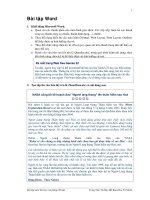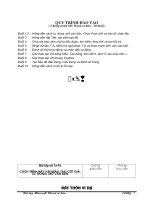Slide toàn tập microsoft word 2013 ch05
Bạn đang xem bản rút gọn của tài liệu. Xem và tải ngay bản đầy đủ của tài liệu tại đây (869.14 KB, 34 trang )
© Paradigm Publishing, Inc.
1
Objectives
Objectives
Chapter 5: Proofing Documents
Performance Objectives
Check the Spelling and Grammar
Create a Custom Dictionary
CHECKPOINT 1
Display the Word Count
Use the Thesaurus
Define Words
Translate Text
CHECKPOINT 2
© Paradigm Publishing, Inc.
2
Objectives
Objectives
Check the Spelling and Grammar
The spelling checker in Word finds misspelled words and offers replacement
words. It also finds duplicate words and irregular capitalizations.
When you spell check a document, the spelling checker compares the
words in your document to the words in its dictionary.
If the spelling checker does not find a match, the spelling checker stops and
selects the following:
a misspelled word, when the misspelling does not match another word
that exists in the dictionary
typographical errors (such as transposed letters)
double word occurrences (such as and and)
irregular capitalization
some proper names
jargon and some technical terms
© Paradigm Publishing, Inc.
3
Objectives
Objectives
Check the Spelling and Grammar continued
To check spelling and grammar:
1. Click the REVIEW tab.
2. Click the Spelling &
Grammar button in the
Proofing group.
Spelling & Grammar button
© Paradigm Publishing, Inc.
4
Objectives
Objectives
Check the Spelling and Grammar continued
misspelled word
© Paradigm Publishing, Inc.
Spelling task pane
5
Objectives
Objectives
Check the Spelling and Grammar continued
selected sentence
© Paradigm Publishing, Inc.
Grammar task pane
6
Objectives
Objectives
Check the Spelling and Grammar continued
Button
Ignore
Ignore All
Add
Delete
Change
Change All
© Paradigm Publishing, Inc.
Function
During spell checking, skips that occurrence of the word;
during grammar checking, leaves currently selected text as
written.
During spell checking, skips that occurrence of the word
and all other occurrences of the word in the document.
Adds selected word to the main spell check dictionary.
Deletes the currently selected word(s).
Replaces selected word in sentence with selected word in
the task pane list box.
Replaces the selected word and all other occurrences of it
with a word in the task pane list box.
7
Objectives
Objectives
Check the Spelling and Grammar continued
When checking the spelling or grammar in a document, you
can temporarily leave the Spelling task pane or Grammar task
pane, make corrections in the document, and then resume
spelling or grammar checking.
Click in the document outside the task pane, make the changes
or edits, and then click the Resume button in the task pane by
clicking the Change, Change All, Ignore, or Ignore All buttons.
The Spelling task pane and Grammar task pane include a
pronunciation feature that will pronounce the word currently
selected in the task pane list box.
© Paradigm Publishing, Inc.
8
Objectives
Objectives
Check the Spelling and Grammar continued
Proofing option
To change spelling or grammar
options:
1. Click the FILE tab.
2. Click Options.
3. Click the Proofing option.
4. Specify the desired options.
5. Click OK.
© Paradigm Publishing, Inc.
9
Objectives
Objectives
Check the Spelling and Grammar continued
When performing a spelling and grammar check, Word stops
and highlights certain text that may contain a grammatical
error and displays the Grammar task pane.
Like the spell checker, the grammar checker does not find every
error in a document and may stop at correct phrases.
The Grammar task pane may also display information on the
grammar rule that may have been broken and offer possible
methods for correcting the error.
© Paradigm Publishing, Inc.
10
Objectives
Objectives
Check the Spelling and Grammar continued
By default, the grammar checker checks only the grammar in a
document.
Customize the type of grammar checking you perform on a
document with options in the When correcting spelling and
grammar in Word section of the Word Options dialog box with
Proofing selected.
© Paradigm Publishing, Inc.
11
Objectives
Objectives
Check the Spelling and Grammar continued
To show readability statistics:
1. Click the FILE tab.
2. Click Options.
3. Click the Proofing option.
4. Click the Show readability
statistics check box.
5. Click OK.
6. Complete a spelling and
grammar check.
© Paradigm Publishing, Inc.
Readability Statistics dialog box
12
Objectives
Objectives
Check the Spelling and Grammar continued
Flesch Reading Ease
Flesch-Kincaid
Grade Level
© Paradigm Publishing, Inc.
This score is based on the average number of syllables
per word and the average number of words per
sentence. The higher the score, the greater the
number of people who will be able to understand the
text in the document. Standard writing generally
scores in the 60-70 range.
This rating is based on the average number of
syllables per word and the average number of words
per sentence. The score indicates a grade level.
Standard writing is generally written at the seventh or
eighth grade level.
13
Objectives
Objectives
Create a Custom Dictionary
When completing a spelling check on a document, Word uses
the RoamingCustom.dic custom dictionary by default.
You can add or remove words from this default dictionary.
In a multiple-user environment, you might also consider
creating your own custom dictionary and then selecting it as
the default.
In this way, multiple users can create their own dictionaries to
use when spell checking a document.
© Paradigm Publishing, Inc.
14
Objectives
Objectives
Create a Custom Dictionary - continued
To create a custom dictionary:
1. Click the FILE tab.
2. Click Options.
3. Click the Proofing option.
4. Click the Custom Dictionaries
button.
Custom Dictionaries button
(continues on next slide)
© Paradigm Publishing, Inc.
15
Objectives
Objectives
Create a Custom Dictionary - continued
5.
6.
7.
Click the New button.
Type a name for the dictionary.
Press Enter.
© Paradigm Publishing, Inc.
New button
16
Objectives
Objectives
Create a Custom Dictionary - continued
To add a word to the custom
dictionary:
custom dictionary dialog box
1. At the Custom Dictionaries
dialog box, click the dictionary
name.
2. Click the Edit Word List button.
3. At the custom dictionary dialog
box, type the desired word in
the Word(s) text box.
4. Click the Add button.
© Paradigm Publishing, Inc.
17
Objectives
Objectives
Create a Custom Dictionary - continued
To change the default dictionary:
1. Click the FILE tab.
2. Click Options.
3. Click the Proofing option.
4. Click the Custom Dictionaries
button.
5. Click the custom dictionary
name.
6. Click the Change Default
button.
7. Click OK.
© Paradigm Publishing, Inc.
Change Default button
18
Objectives
Objectives
Create a Custom Dictionary - continued
To remove a dictionary:
1. Click the FILE tab.
2. Click Options.
3. Click the Proofing option.
4. Click the Custom
Dictionaries button.
5. Click the custom dictionary
name.
6. Click the Remove button.
7. Click OK.
© Paradigm Publishing, Inc.
Remove button
19
Objectives
Objectives
CHECKPOINT 1
1) The Spelling & Grammar button is
located on this tab.
a. HOME
b. INSERT
c. PAGE LAYOUT
d. REVIEW
Answer
Next Question
3) Standard writing is generally
written at this grade level.
a. sixth or seventh
b. ninth or tenth
c. ten or eleventh
d. seventh or eight
Answer
Next Question
2) During spell checking, click this
4) This is the name of the default
option to replace the selected
dictionary.
word with the word in the list
a. ROAMINGCUSTOM.DIC
box.
b. CUSTOMDIC.SPE
a. Ignore
c. CUSTOM.GRA
b. Change
d. CUSTOM.WPD
c. Delete
Answer
Answer
d. Explain
Next Question
Next Slide
Next Question
© Paradigm Publishing, Inc.
Next Slide
20
Objectives
Objectives
Display the Word Count
To display the Word Count
dialog box:
1. Click the word count section
of the Status bar.
OR
2. Click the REVIEW tab.
3. Click the Word Count button
in the Proofing group.
© Paradigm Publishing, Inc.
word count section
21
Objectives
Objectives
Use the Thesaurus
Word offers a Thesaurus feature for finding synonyms,
antonyms, and related words for a particular word.
Synonyms are words that have the same or nearly the same
meaning; antonyms are words that have opposite meanings.
Word may display antonyms as well as synonyms for some
words.
© Paradigm Publishing, Inc.
22
Objectives
Objectives
Use the Thesaurus - continued
To use the Thesaurus:
1. Click the REVIEW tab.
2. Click the Thesaurus button
in the Proofing group.
3. Type the word in the
search text box.
4. Press Enter.
Thesaurus button
© Paradigm Publishing, Inc.
23
Objectives
Objectives
Use the Thesaurus - continued
The thesaurus provides synonyms for the
selected word along with a list of related
synonyms.
The collapse triangle indicates that the list of
related synonyms is expanded. Click the collapse
triangle and the list of related synonyms is
removed from the task pane list box and the
collapse triangle changes to an expand triangle.
As you look up synonyms and antonyms for
various words, you can display the list for
previous words by clicking the Back button
(contains a left arrow) located to the left of the
search text box.
Thesaurus task pane
© Paradigm Publishing, Inc.
24
Objectives
Objectives
Use the Thesaurus - continued
Like the Spelling task pane and Grammar task pane, the
Thesaurus task pane includes a pronunciation feature that will
pronounce the word currently selected.
To hear the word pronounced, click the speaker icon located to
the right of the word below the task pane list box.
© Paradigm Publishing, Inc.
25
Objectives
Objectives









